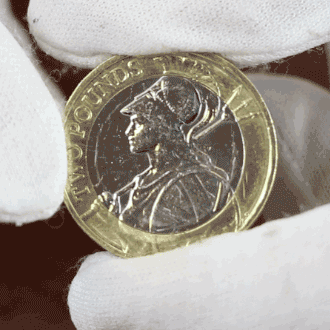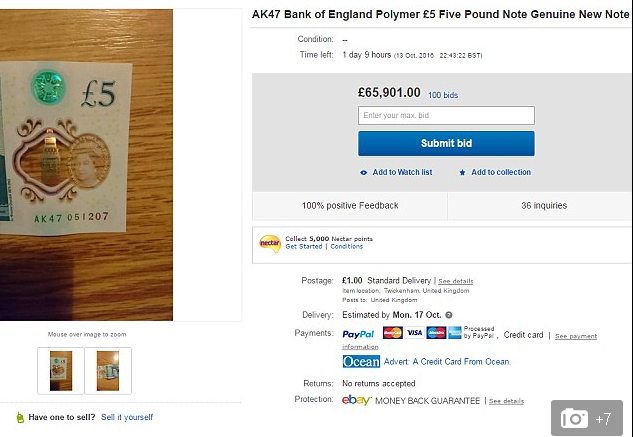Posts Tagged ‘Rare’
Just Discovered: Rare “Inverted Effigy” £2 Coin
It’s time to really start examining your change again.
Change Checker has just been able to confirm that a small number of “Inverted Effigy” £2 Coins have entered circulation.
First discovered by a Change Checker, and now confirmed as genuine by The Royal Mint, this unusual strike appears on a handful of the 2015 Britannia £2 Coins.
The Royal Mint has accounted for the seemingly impossible misalignment of the Queen’s effigy as “almost certainly the result of one of the dies working loose and rotating during the striking process”.
The result is that the Queen’s head is offset by around 150 degrees compared to the Britannia design on the reverse of the coin.
Just how rare is the Inverted Effigy £2 Britannia?
The Royal Mint is unable to give any indication of how many Inverted Effigy coins have entered circulation but we can make some initial estimates.
 The first-year 2015 £2 Britannia is already one of the most-scarce circulating £2 coins ever issued with just 650,000 coins passing through banks and cash centres. That already places it third equal in the all-time low mintage charts.
The first-year 2015 £2 Britannia is already one of the most-scarce circulating £2 coins ever issued with just 650,000 coins passing through banks and cash centres. That already places it third equal in the all-time low mintage charts.
We have analysed 5,000 circulation coins and our results suggest that the Inverted Effigy may have affected as few as 1 in 200 of the coins struck – in other words around just 3,250 coins.
Of course, if the Inverted Effigy is a consequence of the die slipping during the striking process, it is possible that there may be other variations where the Queen’s head is less or more misaligned as the die has worked its way out of position.
Errors, mis-strikes and myths
Of course, given the many million coins The Royal Mint strike each year, it is to their immense credit that mis-strikes and errors are so few and far between. But, of course, when they do arise, they cause great collector excitement, as some of these other examples pay testament to.
- The Undated 20p – read more
- The “Silver” 2p – read more
- The 2014 Year of the Horse Silver £2 – read more
But there are a few myths out there too – upside down edge lettering, the “Pemember” Gunpowder Plot £2 coin and the “Necklace” £2 coin, which all have perfectly normal explanations.
Buyers beware
But finally a note of caution. I’m sure in time we’ll see some “examples” of the Inverted Effigy £2 for sale online. Before you think of buying one, please beware. Are you seeing a genuine Inverted Effigy or just a coin that someone has rotated in a photograph to make it look inverted?
Why your AK47 £5 note isn’t worth £80,000 and other myths about the polymer banknote
Time and again we hear from people with various serial numbers asking how much their £5 notes are worth, so we thought we would address some of the myths about the £5 polymer banknote.
The rare £5 note with serial number AK47 that ‘sold’ for over £80,000 on eBay!
Notes with the serial number AK47 have been particularly popular thanks to the machine gun connotations. Back in 2016, news emerged that a £5 banknote with the prefix Ak47 had fetched a winning bid of £80,100 on the online market place eBay. The seller must have been overjoyed with the jackpot amount but it turned out the buyer had no intention of paying up.

The bidding on this Ak47 banknote fetched a winning bid of £80,100
As much as we love the design of the new fiver, there is no way we would pay anywhere near £80,000 for it, no matter what serial number it had.
Or the fivers with a James Bond theme?
Described as an “AK37 007 James Bond Bank of England Polymer £5 note” in a lovely condition, this banknote sold for £5,000.

A James Bond themed £5 listing on eBay.
Although there must be plenty of James Bond fanatics out there, we can think of so many other items of James Bond memorabilia that fans could spend £5,000 on! And realistically, if you had the choice, which would you prefer to spend £5K on?
What about the AA01 banknotes?
When they were first released, the new polymer banknotes created a collecting storm. In fact I’m almost certain that every single person in the country checked their new note at some point to see if they were lucky enough to find one with the prefix AA01.
Although a banknote with the prefix AA01 might be worth slightly over face value to someone who is genuinely interested, we must remember that 1 million AA01 banknotes were printed. So as much as I wish it could be true, reality check – don’t expect a big payout if you do find one.
And the upside down fiver?
There were countless stories and accounts of plastic banknotes fetching eye-watering sums of money after the launch, but one eBay seller took things a step further when he listed his ‘upside down’ banknote.

The ‘upside down’ fiver
Although the seller stated in the description that the listing was a joke, he still received lots of serious questions about the note.
However…
Do look out for these £5 notes worth more than £20,000 in circulation! If you come across a fiver with a micro-engraved portrait of either Jane Austen or Harry Kane, whatever you do, do NOT spend it.

Micro-engraver Graham Short has created special £5 notes, engraved with tiny portraits. The first set features author Jane Austen and more recently notes featuring Harry Kane have been put into circulation and could be worth more than £20,000. In fact, Graham Short’s work has an insurance valuation of £50,000 so these £5 notes will give you an extra £49,995 of value if you find one…
Serious Collectors: What to look for…
Collecting banknotes is a serious hobby that many thousands of people all over the world enjoy.
There are many ways of assembling collections of banknotes, for example banknotes that feature famous people (scientists, writers or politicians) or banknotes with historical context such as those from a certain era.
Generally collecting banknotes is not about the serial number it possesses, instead the chief cashier is of most interest, particularly on UK banknotes. This is where real rarities can be found – in the form of Chief Cashier signatures.
Banknote designs rarely change but on average cashiers change every 5 or 6 years with some in the position for as little as 3 years.

These £5 polymer banknotes will always be considered the ‘first’ polymer banknotes regardless of what serial number they hold and importantly uncirculated notes or those in good condition will also always be more sought after.
So if you are genuinely interested in collecting banknotes, the chief cashier is what you should really be looking for.
If you’re interested in coin collecting, our Change Checker web app is completely free to use and allows users to:
– Find and identify the coins in their pocket
– Collect and track the coins they have
– Swap their spare coins with other Change Checkers
Sign up today at: www.changechecker.org/app
Is there an even rarer version of the Navy £2 in circulation?
Change Checkers have been speculating whether there are two different design variations of the 2015 Navy £2 coin that was released into circulation a couple of months ago.
This coin has already caused a stir in the collecting world as we revealed it was one of the rarest £2 coins with just 650,000 struck for circulation.

The 2015 Navy £2 coin was released into circulation a couple of months ago.
The original Navy £2 design (above) shows the coin without any markings on the top right of the mast, but we’ve seen a few £2’s out there that look like they have a flying flag.

A number of people have been enquiring about whether there were two different designs of the Navy £2 coin struck for circulation.
As you can see from the two coins pictured above, the coin on the right looks like it has a flying flag on the mast whereas the first coin is free from any markings.
So are there two different designs?
No – The Royal Mint strike up to 5 billion coins a year and from time to time cracks in the die can cause pools of metal to form on the coin.
It just so happens that this bit of metal has caused the markings on these coins to look like a flying flag on the ship fueling speculation that two different variations were struck.
Well done to the eagle-eyed change checkers out there who spotted differences between the coins. It’s the little details like these that make collecting so interesting so remember to always check your change carefully.
Have you checked your Navy £2?
Let us know via Facebook, Twitter or leave us a comment below.


